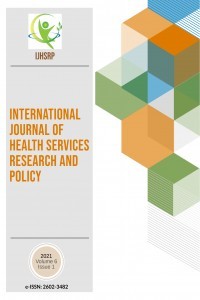IMMUNOHISTOCHEMICAL ANALYSIS OF SFLT-1 AND ADAMTS-8 EXPRESSION IN DIABETIC RAT TESTIS TISSUE
IMMUNOHISTOCHEMICAL ANALYSIS OF SFLT-1 AND ADAMTS-8 EXPRESSION IN DIABETIC RAT TESTIS TISSUE
Abstract: The aim of this study was to determine the testicular inflammation and angiogenetic effect of diabetes with ADAMTS-8 and SFlt-1 proteins immunohistochemically. Wistar albino male rats (n: 12)were used for the study, Group 1: Control group (n: 6), only 1 ml i.p. saline injection was performed. Group 2: Diabetes group (n: 6) received a single intraperitoneal dose of streptozotocin (STZ) of 60 mg / kg. The glucose value measured above 250 mg / dl was considered as diabetic. Under anesthesia, dissection was performed at the lower part of abdominal clearance and testicular tissue was removed. Testis tissues were fixed in 10% neutral formalin, followed by the routine paraffin protocol and cut with a microtome. Then, primary antibodies (ADAMTS-8, sFlt-1) were applied by immunohistochemistry method and incubated at +4 ˚C overnight. The sections were then examined under a light microscope. Diabetes group showed that Leydig cells in the inter tubular area had vacuolization and capillary dilatations in histopathological examinations. sFlt-1 staining of control group showed positive expression in capillary endothelium between Leydig chambers of the intertubular area. Sflt-1 expression of diabetes group was observed in degenerative spermatic cells and Sertoli cells of the basement membrane facing tubules. The expression of ADAMTS-8in control group was positive in some Leydig cells in the interstitial area of Sertoli cells in seminiferous tubule but, spermatogenetic cells were negative. In the ADAMTS-8 staining of diabetes group, the expression of ADAMTS-8 was increased in the stromal cells and some inflammatory cells in the intertubular space. SFlt-1 plays a crucial role in angiogenesis as well as in diabetic testes and is marked as a precursor for the disruption of vascular structure and blood flow due to degenerative changes. It is thought that the distribution of ADAMTS-8 may be a determinant protein in the development of extracellular matrix and in damage to testicular tissue of diabetic testis.
Keywords:
diabetes, testis, ADAMTS-8, sFlt-1, immunohistochemistry,
___
- [1] Rowley WR, Bezold C, et al., ‘‘Diabetes 2030: insights from yesterday, today, and future trends’’, Popul Health Manag, 20(1), 6–12, 2017.
- [2] Feng SL, Li S H, et al., ‘‘Effect of ligustrum fruit extract on reproduction in experimental diabetic rats’’, Asian J Androl, 3, 71–73, 2001.
- [3] Guneli E, Tugyan K, et al., ‘‘Effect of melatonin on testicular damage in streptozotocin-induced diabetes rats’’, Eur Surg Res, 40(4), 354–360, 2008.
- [4] Oksanen A., ‘‘Testicular lesions of streptozotocin diabetic rats’’, Horm Res, 6(3), 138–144, 1975.
- [5] Sexton WJ, Jarow JP., ‘‘Effect of diabetes mellitus upon male reproductive function’’, Urology, 49(4), 508–513, 1997.
- [6] Po K., ‘’Streptozotocin-induced diabetes increases apoptosis through JNK phosphorylation and Bax activation in rat testes’’, J Vet Med Sci, 69(9), 969-71. 2007.
- [7] Alves MG, Martins AD, et al., ‘’Molecular mechanisms beyond glucose transport in diabetes-related male in fertility’’, Biochim Biophys Acta, 1832(5), 626-35, 2013.
- [8] Rawlings ND, Tolle DP, Barrett AJ., ‘’MEROPS: the peptidase database’’, Nucleic Acids Res, 32, 160–4 2004.
- [9] Porter S, Ian M, et al., ‘’The ADAMTS metalloproteinases’’, Biochem J, 386, 15–27, 2005.
- [10] Yamaji N, Nishimura K, et al., ‘’Novel metalloprotease having aggrecanase activity’’, Yamanouchi Pharmaceutical, Japan, 2001.
- [11] Wagsater D, Bjork H, et al., ‘‘ADAMTS-4 and 8 are inflammatory regulated enzymes expressed in macrophage-rich areas of human at hero sclerotic plaques’’, Atherosclerosis, 196(5), 14-22, 2008.
- [12] Vazquez F, Hastings G, et al., ‘’METH 1, a human ortholog of ADAMTS-1, and METH-2 are members of a new family of proteins with angio-inhibitory activity’’, J Biol Chem, 274(233), 49-57, 1999.
- [13] Dincel CG, Yildirim S., ‘‘Overexpression of ADAMTS-13 and neuronal nitric oxide synthase relates with neuropathology in streptozotocin-induced type 1 diabetic’’, Int J Clin Exp Pathol, 9(4), 4761-4778, 2016.
- [14] Shibuya, M., et al., ‘‘Nucleotide sequence and expression of a novel human receptor-type tyrosine kinase gene (flt) closely related to the fms family’’, Oncogene, 5(4), 519-24. 1990.
- [15] Farina A, Eklund E, et al., ‘‘First-trimester biomarker panel for predicting the development of gestational diabetes’’, Reprod Sci, 24(6), 954-959, 2017.
- [16] Lin SH, Wang ZS., ‘‘Study on the expression of androgen receptor in testis, epididymis and prostate of adult rats with diabetes’’, Zhonghua Nan Ke Xue 11(4), 891, 2005.
- [17] Kılıç ÖM, Aynekin B, et al., ‘‘Differentially regulated ADAMTS1, 8, 9, and 18 in pancreas adenocarcinoma’’, Prz Gastroenterol, 12 (4), 262–270, 2017.
- [18] Zhao C, Zya Y, et al., ‘‘The quantification of ADAMTS4 and 8 expression and selection of reference genes for quantitative real-time PCR analysis in myocardial infarction’’, Biomed Pharmacother, 65(8), 555-9, 2011.
- [19] Di Marco SG, Reuter S, et al., ‘‘The Soluble VEGF Receptor sFlt1 Contributes to Endothelial Dysfunction in CKD’’, J Am Soc Nephrol, 20(10), 2235-2245, 2009.
- [20] Irtegun S, Deveci E., ‘‘Examining the Expression Level of VEGF and Bcl-2 By Immunohistochemistry and Western Blot in Testis Tissue of Diabetic Rats’’, J Med Dicle, 43(4), 527-533, 2016.
- Yayın Aralığı: Yılda 3 Sayı
- Başlangıç: 2016
- Yayıncı: Rojan GÜMÜŞ
Sayıdaki Diğer Makaleler
A COST-EFFECTIVENESS COMPARISON OF THE OPEN AND LAPAROSCOPIC APPENDECTOMIES FOR PEDIATRIC PATIENTS
Amita BHADAURİA, Amogh BHATNAGAR
IMMUNOHISTOCHEMICAL ANALYSIS OF SFLT-1 AND ADAMTS-8 EXPRESSION IN DIABETIC RAT TESTIS TISSUE
Seval KAYA, Yusuf NERGİZ, Fırat ASIR, Ebru GÖKALP ÖZKORKMAZ, Gamze ERDOGAN, Engin DEVECİ
EFFECT OF LONELINESS IN THE WORKPLACE ON EMPLOYEES’ JOB PERFORMANCE: A STUDY FOR HOSPITAL EMPLOYEES
RISKS ANALYSIS IN CATERING INDUSTRY
Tolga ANKARALIGİL, Ayşe ÖZDEMİR
